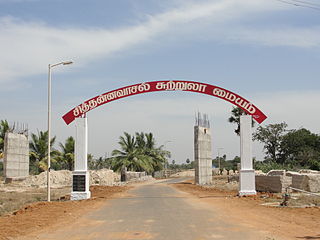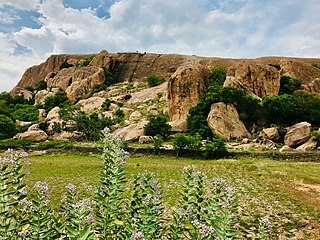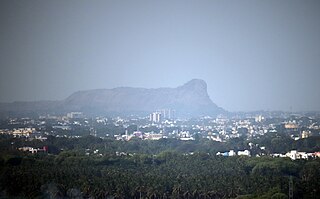
Tamil Jains are ethnic-Tamils from the Indian state of Tamil Nadu, who practice Jainism,. The Tamil Jain is a microcommunity of around 85,000 .They are predominantly scattered in northern Tamil Nadu, largely in the districts of Tiruvannamalai, Kanchipuram, Vellore, Villupuram, Ranipet and Kallakurichi. Early Tamil-Brahmi inscriptions in Tamil Nadu date to the third century BCE and describe the livelihoods of Tamil Jains. Samaṇar wrote much Tamil literature, including the important Sangam literature, such as the Nālaṭiyār, the Cilappatikaram, the Valayapathi and the Civaka Cintamani. Three of the five great epics of Tamil literature are attributed to Jains.
Sholavandan is a panchayat town in Madurai district in the Indian state of Tamil Nadu, India. It is located on the left bank of the Vaigai River, sixteen miles north west of Madurai. It is one of 12 "town- panchayats" of Madurai district.

Thiruparankundram, also spelled Tirupparankundram or Tiruparangundram, is a neighbourhood in Madurai city in Tamil Nadu, India. It is about 7 kilometres (4.3 mi) from Periyar Bus Terminus, the centre of the city and constitutes the southwest part of the Madurai city. The town's landmark and fame is the huge monolithic rock hill that towers to a height of 1,048 feet (319 m) and has a circumference of over 2 miles (3.2 km). It is a home to many ancient and historic monuments including Jain caves, some protected as India's national monuments.

Tamil-Brahmi, also known as Tamili or Damili, was a variant of the Brahmi script in southern India. It was used to write inscriptions in Old Tamil. The Tamil-Brahmi script has been paleographically and stratigraphically dated between the third century BCE and the first century CE, and it constitutes the earliest known writing system evidenced in many parts of Tamil Nadu, Kerala, Andhra Pradesh and Sri Lanka. Tamil Brahmi inscriptions have been found on cave entrances, stone beds, potsherds, jar burials, coins, seals, and rings.
Ennayiram is a village in Vikravandi taluk in Villuppuram district in the Indian state of Tamil Nadu. The major occupation of the people living at this place is agriculture.
Cholapandiyapuram or Cholavandipuram or Cholapandipuram is a 1 sq. kilometre village in Tirukkoyilur taluk in Kallakurichi district in the Indian state of Tamil Nadu. Agriculture is the primary occupation of the people who live in this area. In 2011, the village had a population of 1,000 people.
Jambai is a 1 km2 (0.39 sq mi) village in Tirukkoyilur taluk in Kallakurichi district in the Indian state of Tamil Nadu. The major occupation of the people living at this place is agriculture and handloom. In 2011, it had a population of 2,000 people.

Jainism has an extensive history in the Indian state of Tamil Nadu, although practiced by a minority of Tamils in contemporary times. According to the 2011 India Census, Jains represent 0.12% of the total population of Tamil Nadu, and are of the Digambara sect. Tamil Jains are primarily concentrated in northern Tamil Nadu, in the districts of Madurai, Viluppuram, Kanchipuram, Vellore, Tiruvannamalai, Cuddalore and Thanjavur.
Sethavarai is a small village in Gingee taluk in Villuppuram district in the Indiain state of Tamil Nadu. The major occupation of the inhabitants is agriculture. In 2017 it had a population of 1100(apex).
Kanjur or Kanchiyur is a hamlet in Gingee taluk in Villuppuram district in the Indian state of Tamil Nadu. The major occupation of the people living at this place is agriculture. In 2011 it had a population of 400.
Onampakkam is a small village in Maduranthakam taluk in Chengalpattu district in the Indian state of Tamil Nadu. The major occupation of the people living at this place is agriculture. In 2011, it had a population of 4000.
Seeyamangalam is a small village in Vandavasi taluk in Tiruvannamalai district in the Indian state of Tamil Nadu. The major occupation of the people living at this place is agriculture. As of 2011, it had a population of 1665. The place is known for the Avanibhajana Pallaveshwaram temple.

Sittanavasal is a small hamlet in Pudukkottai district of Tamil Nadu, India. It is known for the Sittanavasal Cave, a 2nd-century Jain cave complex. From the 7th to the 9th century A.D., the village flourished as a Jain centre.

Samanar Hills, also known as Samanar Malai or Amanarmalai or Melmalai, is a rocky stretch of hills located near Keelakuyilkudi village, 10 kilometres (6.2 mi) west of Madurai city, Tamil Nadu, India. They stretch east–west over 3 kilometers towards Muthupatti village. These rocky hillocks are home to many Jain and Hindu monuments. The hill has been declared as a protected monument by the Archaeological Survey of India.

Armamalai Cave is known for its Indian cave paintings. It is to the west of Malayampattu village which is 25 kilometres (16 mi) from Ambur in the Tirupattur district of Tamil Nadu. The cave is in the protected monument by the Archaeological Survey of India and it is a Tamil Nadu tourist attraction.

Yanaimalai is a protected monument and tourist attraction in Tamil Nadu, India. It has Jain sculptures, a Shaivite temple, and a Vaishnavite temple, namely the Narasingam Yoga Narasimha Perumal Temple.

Mangulam or Mankulam is a village in Madurai district, Tamil Nadu, India. It is located 25 kilometres (16 mi) from Madurai. The inscriptions discovered in the region are the earliest Tamil-Brahmi inscriptions.

Keezhavazhavu is a village in Madurai district of Tamil Nadu, India. It is located 43 kilometres (27 mi) from Madurai. It is known for two hillocks called Panchapandavar Malai or Panchapandavar Padukkai which contains ancient Jain sculptures and stone beds, and another is Sakkarai peer oliulla Mountain. It has a cave.
Neganur Village is a 6.5 square kilometres (2.5 sq mi) village in Gingee taluk, Villupuram District in the India state of Tamil Nadu. The main activity is cultivating agricultural crops such as rice, groundnut, etc.

This is a list of archaeological artefacts and epigraphs which have Tamil inscriptions. Of the approximately 100,000 inscriptions found by the Archaeological Survey of India in India, about 60,000 were in Tamil Nadu















